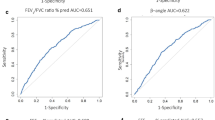Abstract
Background
Previous studies have focused upon the relationship between airway inflammation and hyperresponsiveness with different conclusions. We re-examined the relationship between airway inflammation (FENO), hyperresponsiveness to methacholine (AHR), and calibre (FEV1 % predicted) in mild-to-moderate asthmatics.
Methods
We searched our database for asthmatics who had attended our research department. FEV1 % predicted, FENO, and methacholine PC20 were collected. Patients were divided into groups based upon AHR as follows: severe (<0.5 mg/ml, group A), moderate (>0.5–2 mg/ml, group B), and mild (>2–8 mg/ml, group C), and upon FENO: low (<25 ppb, group D), medium (25–50 ppb, group E), and high (>50 ppb, group F).
Results
In 208 asthmatics, when stratified by AHR, there was an 8.5% difference in FEV1 % predicted (95% CI 2.6–14.4%; P = 0.002) and a 29% difference in FENO between groups A and C (95% CI 2–48%; P = 0.034). When stratified by FENO, there was a 1.29 doubling dilution difference in methacholine PC20 (95% CI 0.26–2.33; P = 0.009) between groups D and F. There was no difference between FEV1 % predicted when grouped by FENO. Multivariate regression analysis with covariates, including inhaled corticosteroids, supported our findings from categorical analysis.
Conclusions
We found no relationship between airway inflammation and calibre, whilst showing significant relationships between AHR and airway calibre and AHR and airway inflammation. Whilst relationships exist, the lack of complete concordance highlights the important role each contributes to the assessment of the asthmatic individual.

Similar content being viewed by others
References
Lim KG, Mottram C (2008) The use of fraction of exhaled nitric oxide in pulmonary practice. Chest 133:1232–1242
Dweik RA, Sorkness RL, Wenzel S, Hammel J, Curran-Everett D, Comhair SA, Bleecker E, Busse W, Calhoun WJ, Castro M, Chung KF, Israel E, Jarjour N, Moore W, Peters S, Teague G, Gaston B, Erzurum SC (2010) Use of exhaled nitric oxide measurement to identify a reactive, at-risk phenotype among patients with asthma. Am J Respir Crit Care Med 181:1033–1041
Sont JK, Willems LN, Bel EH, van Krieken JH, Vandenbroucke JP, Sterk PJ (1999) Clinical control and histopathologic outcome of asthma when using airway hyperresponsiveness as an additional guide to long-term treatment. The AMPUL Study Group. Am J Respir Crit Care Med 159:1043–1051
Langley SJ, Goldthorpe S, Custovic A, Woodcock A (2003) Relationship among pulmonary function, bronchial reactivity, and exhaled nitric oxide in a large group of asthmatic patients. Ann Allergy Asthma Immunol 91:398–404
Crimi E, Spanevello A, Neri M, Ind PW, Rossi GA, Brusasco V (1998) Dissociation between airway inflammation and airway hyperresponsiveness in allergic asthma. Am J Respir Crit Care Med 157:4–9
Reid DW, Johns DP, Feltis B, Ward C, Walters EH (2003) Exhaled nitric oxide continues to reflect airway hyperresponsiveness and disease activity in inhaled corticosteroid-treated adult asthmatic patients. Respirology 8:479–486
Dupont LJ, Rochette F, Demedts MG, Verleden GM (1998) Exhaled nitric oxide correlates with airway hyperresponsiveness in steroid-naive patients with mild asthma. Am J Respir Crit Care Med 157:894–898
Miller MR, Hankinson J, Brusasco V, Burgos F, Casaburi R, Coates A, Crapo R, Enright P, van der Grinten CP, Gustafsson P, Jensen R, Johnson DC, MacIntyre N, McKay R, Navajas D, Pedersen OF, Pellegrino R, Viegi G, Wanger J (2005) Standardisation of spirometry. Eur Respir J 26:319–338
Crapo RO, Casaburi R, Coates AL, Enright PL, Hankinson JL, Irvin CG, MacIntyre NR, McKay RT, Wanger JS, Anderson SD, Cockcroft DW, Fish JE, Sterk PJ (2000) Guidelines for methacholine and exercise challenge testing–1999. This official statement of the American Thoracic Society was adopted by the ATS Board of Directors, July 1999. Am J Respir Crit Care Med 161:309–329
American Thoracic Society; European Respiratory Society (2005) ATS/ERS recommendations for standardized procedures for the online and offline measurement of exhaled lower respiratory nitric oxide and nasal nitric oxide. Am J Respir Crit Care Med 171:912–930
van Rensen EL, Straathof KC, Veselic-Charvat MA, Zwinderman AH, Bel EH, Sterk PJ (1999) Effect of inhaled steroids on airway hyperresponsiveness, sputum eosinophils, and exhaled nitric oxide levels in patients with asthma. Thorax 54:403–408
Wilson AM, Lipworth BJ (2000) Dose-response evaluation of the therapeutic index for inhaled budesonide in patients with mild-to-moderate asthma. Am J Med 108:269–275
Acknowledgment
This research was supported by departmental funds from the Asthma and Allergy Research Group, University of Dundee.
Author information
Authors and Affiliations
Corresponding author
Rights and permissions
About this article
Cite this article
Short, P.M., Lipworth, S.I.W. & Lipworth, B.J. Relationships Between Airway Hyperresponsiveness, Inflammation, and Calibre in Asthma. Lung 189, 493–497 (2011). https://doi.org/10.1007/s00408-011-9328-x
Received:
Accepted:
Published:
Issue Date:
DOI: https://doi.org/10.1007/s00408-011-9328-x




